Elite life

Mushrooms
Boletus
║ Mushrooms ║
King Bolete, Penny Bun, Porcini, Cep (Boletus edulis)

Ecology: Mycorrhizal with conifers, especially spruce and (in some locations) with hardwoods; growing alone, scattered, or gregariously; summer and fall; widely distributed. In North America this mushroom is more common from the Rocky Mountains westward, but is occasional in the east.
Cap: 8-30 cm, convex in the button stage, becoming broadly convex to nearly flat; tacky when wet; smooth, like well buffed leather; light brown to brown to dark vinaceous brown (sometimes nearly red).
Pore Surface: Whitish at first, becoming yellow to olive; tubes same; pores tightly packed at first; not bruising or, in age, bruising olive. Stem: 8-20 cm long; 2-10 cm thick at apex; usually club-shaped to nearly club-shaped when young (rarely equal), club-shaped to equal; finely reticulate over at least the upper half; white, or white below and brownish above.
Flesh: White, solid, unchanging; sometimes tinged with rose shades near the cap surface and around worm holes; rarely discoloring slightly blue near the tubes.
Queen Bolete, Bronzy Bolete (Boletus aereus)
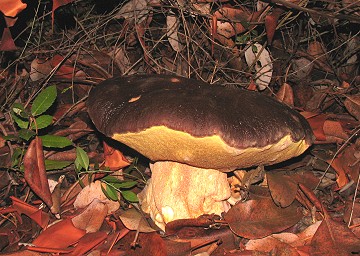
Pileus: Cap 7.0-14.0 (17) cm broad, convex, expanding to plano-convex; margin incurved, later decurved to nearly plane, not overlapping the tube layer; surface moist, more or less glabrous when young, becoming irregularly pitted or wrinkled; color at first unevenly buff-brown to pale chestnut-brown, overlain initially with a whitish bloom, in age becoming medium-brown to dark-brown, subviscid when moist; context up to 2.0 cm thick white, unchanging, firm in youth, soft at maturity, tinged pinkish-vinaceous below the cuticle, sometimes yellowish above the tube layer; odor and taste mild.
Hymenophore: Pores up to 3 mm when young, stuffed, approximately 1 mm in age, whitish, becoming cream-colored to dull pale-yellow, eventually dingy yellowish-olive, not bluing, darkening slightly where handled; tubes up to 2.0 cm long, occasionally discoloring brownish when cut, not bluing, depressed at the stipe.
Stipe: Stipe 7.0-13.0 cm long, 3.0-4.0 cm thick, solid, clavate to ventricose in youth, subclavate to equal at maturity; surface of apex reticulate, whitish, elsewhere glabrous to faintly wrinkled; context of stipe, not bluing, but darkening slightly when cut; partial veil absent.
Spores: Spores 11.5-13.5 x 3.5-4.5 mm, smooth, thin-walled, narrowly ellipsoid in face-view, hilar appendage inconspicuous, one to several guttules; spore print dull olive-brown.
Habitat: Solitary to scattered in mixed hardwood/conifer forests; fruiting shortly after the fall rains.
Summer Cep, Summer Bolete (Boletus aestivalis, Boletus reticulatus)
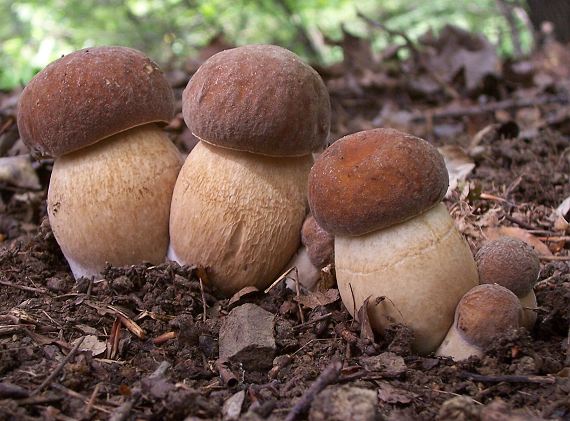
The summer cep is a mushroom with a bulbous stem, large cap (5 to 20 cm in diameter) with a brown to dark brown cuticle. In dry weather, the caps often crack giving the appearance of a fine net as the pale flesh is revealed. The tubes and pores are initially white, darkening with age to pale yellow and then brown. They have a central stipe (13-16 cm tall) which has a strongly marked reticulated pattern and is colored brown, sometimes even as intense as the cap colour. The darker shade is a key feature distinguishing this species from B. edulis. The flesh is white and thick and remains firm if yellowish as the mushroom ages and is often attacked by insect larvae. Its odour is pleasant.
Royal Bolete, Butter Bolete (Boletus regius)
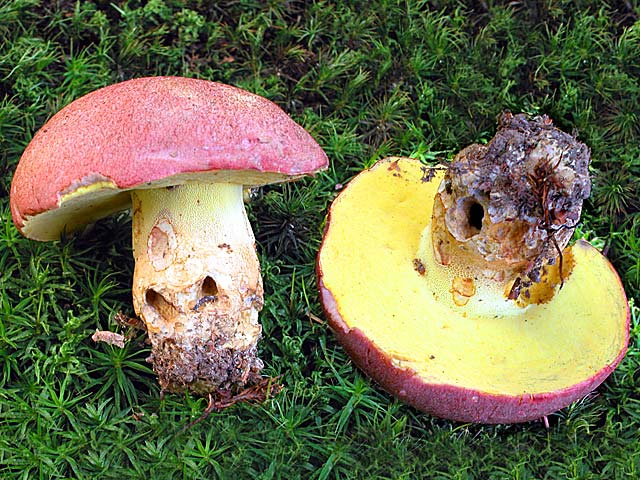
Pileus: Cap 8.0-15.0 (20) cm broad, strongly convex, expanding to plano-convex; margin incurved, becoming decurved to plane in age; surface subviscid when moist, otherwise dry, with irregular bumps, pits and depresssion, at first ornamented with patches of appressed fibrils, these often wearing away in age, then appearing glabrous; color rose-red to pale-pink, quickly fading with exposure to light to various combinations of buff, tan, or dull pale-yellow; context lemon-yellow, firm, up to 2.5 cm thick, slowly bluing when cut or injured, bluing reaction strongest just above the tube layer; odor mild; taste mild, pleasant.
Hymenophore: Pores lemon-yellow when young, 2-3 per mm, maturing to dingy-yellowish with a slight olivaceous tint, 1-2 per mm in age, bluing when bruised; tubes adnate in attachment, becoming depressed in age, up to 2.5 cm long, pale-yellow, bluing like the pores.
Stipe: Stipe 5.0-9.0 cm long, 3.0-4.0 cm thick at apex, clavate to sub-bulbous, solid, fleshy; surface of upper half conspicuously reticulate, the ornamentation and background color yellowish, sometimes becoming pallid, occasionally bluing when young; cortex yellowish, otherwise white, unchanging, often reddish at the base; partial veil absent.
Spores: Spores 13.0-15.5 x 4.0-5.0 mm, elliptical to slightly spindle-shaped in face-view, smooth, thin-walled; spore print olive-brown.
Habitat: Solitary, scattered to clustered, spring and fall under conifers in the Sierra, and in mixed confer-hardwood forests along the coast during the fall, possibly also in the spring.
White King Bolete (Boletus barrowsii)
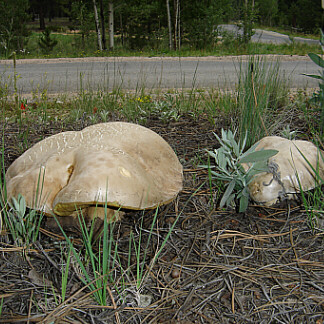
The cap is 6-25 cm (2-10 in) in diameter, initially convex in shape before flattening, with a smooth or slightly tomentose surface, and gray-white, white or buff colour. The thick flesh is white and does not turn blue when bruised. The pores are initially whitish, later yellow. The spore print is olive brown, the spores are elliptical to spindle-shaped and 13-15 x 4-5 μm in dimensions. The stout stipe is white with a brown reticulated pattern, and may be 6-20 cm (2½-8 in) high with an apical diameter of 2-6 cm (1-2 in). Like B. edulis, it is often found eaten by maggots.
Boletus subglabripes
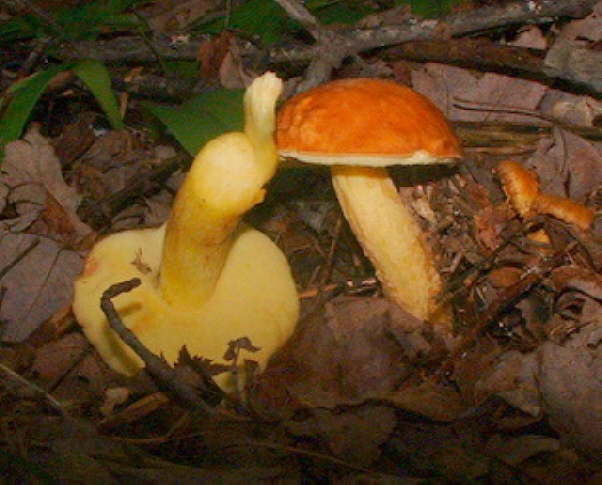
Singer Cap 4-10 cm across, convex then expanding to almost plane; light brown to rich cinnamon, yellow-brown, or reddish brown; dry, glabrous to slightly viscid when wet. Tubes deeply depressed around stem; lemon yellow to olive-yellow. Pores yellow to amber yellow, not changing on injury. Stem 50-100 x 10-20 mm, even and tapered at the base; pale to bright yellow, occasionally staining reddish at base; entire surface covered with scurfy, scabrous squamules (never reticulate), dry, often with distinct white mycelial remains at base. Flesh pale to bright lemon yellow, sometimes faintly blue on cutting. Odor not distinctive. Taste mild to slightly acidic. Spores subfusiform, smooth, (11)12-14(17) x 3-3.5(5) mm. Deposit pale olive-brown.
Red-Cracked Bolete (Boletus chrysenteron)
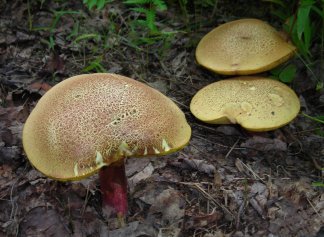
Pileus: Cap 4-9 cm broad, convex, becoming nearly plane in age; surface dry, tomentose, dark brown to olive brown, soon areolate, the exposed context pallid at the disc, pinkish near the margin; flesh white, thick, sometimes blueing when bruised; odor mild, taste acidic.
Hymenophore: Pores relatively large, 1-2 mm, yellow, olive-brown in age, typically bruising blue.
Stipe: Stipe 5-10 cm tall, 1.0-1.5 cm thick, dry, smooth to longitudinally ridged, yellowish, with reddish tints usually predominating at the base.
Spores: Spores 11.5-14.0 x 4-6 μm, smooth, elliptical to fusiform; spore print olive-brown.
Lurid Bolete (Boletus luridus)
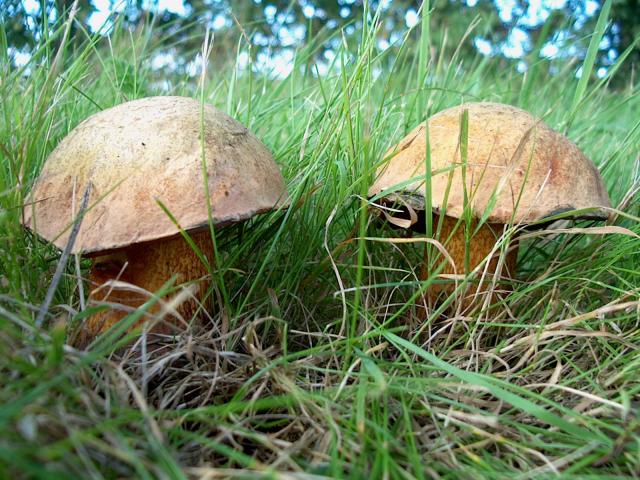
Cap: Immature specimens, such as the one shown here, are downy and pale yellow. As the fruiting body matures, the cap, which expands to between 8 and 14 cm (exceptionally 20 cm) in diameter, becomes dull yellow-brown. The yellow cap flesh turns blue-black if it is cut or bruised.
Tubes and Pores: Beneath the cap, yellow spore tubes terminate in tiny circular pores that are at first yellow but eventually turn orange-red. When cut or bruised, the tubes and pores rapidly turn blue-black before fading to pale blue.
Stipe: 1.5 to 4 cm in diameter and 5 to 10 cm tall, the swollen stem turns dark blue when cut and then fades back to a light blue colour, as seen here. The flesh near the base of the stem is deep yellow with red tinges. The surface of the stem is yellow, covered with a red mesh patterning everywhere except for the top of the stem, which remains yellow.
Spore print: Olive-brown.
║ Mushrooms ║